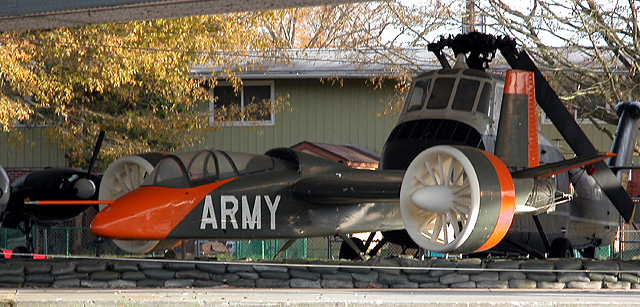
The Italian Aerospace Information Web
by Aeromedia - corso Giambone 46/18 - 10135 Torino (Italy)
Doak 16 VZ-4-DA 56-6942 in esposizione all’U.S. Army Transportation Museum di Fort Eustis, in Virginia, USA. Il Doak Model 16 è stato il primo velivolo a decollo ed atterraggio verticale (VTOL) a sperimentare con un certo successo il concetto dell’elica intubata girevole. Esso fu progettato all’inizio degli anni ‘50 dalla Doak Aircraft Company di Torrance, California, ed un esemplare venne acquistato, nel 1956, dall’U.S. Army Transportation Research and Engineering Command, che gli diede la sigla VZ-4-DA (DA = Doak Aircraft). Il biposto in tandem VZ-4 era propulso da una turbina Lycoming T53-L1 da 1.000 shp che muoveva due eliche intubate poste alle estremità alari, orientabili di 90 gradi. Per decollare, il pilota poneva le eliche in posizione orizzontale, spostandole progressivamente in posizione verticale per passare al volo normale. Per l’atterraggio, le eliche intubate del Doak venivano riportate lentamente in posizione orizzontale. Le fasi di decelerazione e discesa dovevano essere controllate con cura per evitare lo stallo del bordo d’attacco dei condotti delle eliche. Il VZ-4 riuscì a sperimentare decolli ed atterraggi convenzionali, corti e verticali. Benchè il velivolo presentasse alcuni inconvenienti nel comportamento in volo, solo alcuni erano dovuti direttamente alle eliche intubate, e furono comunque eliminati. Una delle caratteristiche più negative dovute al sistema di propulsione, era la tendenza del mezzo a sollevare il muso durante la transizione dal volo verticale a quello orizzontale. Il VZ-4 fu l’ultimo velivolo prodotto dalla Doak, pioniera della ricerca nel campo del decollo verticale, e si dimostrò prezioso per verificare il potenziale militare di mezzi VTOL che non fossero dei veri e propri elicotteri. Dopo tre anni di sperimentazioni congiunte tra l’Esercito degli Stati Uniti e la NASA, il VZ-4 fu radiato dai ranghi dell’U.S. Army e lasciato alla NASA per ulteriori sperimentazioni. Al termine di quest’ultimo ciclo di prove, il Doak VZ-4 fu trasferito all’Army Transportation Museum di Fort Eustis, in Virginia, dove è tuttora conservato. (Aeromedia)
Doak 16 VZ-4-DA 56-6942 on display at the U.S. Army Transportation Museum at Fort Eustis, Virginia, USA. The Doak Model 16 was the first vertical take-off and landing (VTOL) aircraft to demonstrate the tilt duct concept successfully. It was first proposed in the early 1950s by Doak Aircraft Company of Torrance, California, and in 1956, the U.S. Army Transportation Research and Engineering Command purchased one, and designated it the VZ-4. The tandem two-seat VZ-4 was powered by a single 1,000 shp Lycoming T53-L1 turbine engine driving two ducted propellers on the wing tips which rotated 90 degrees. The pilot rotated the propeller ducts to horizontal position for take-off and then returned them to vertical position for forward flight. To land the Doak, the propellers were again turned horizontally. Deceleration and descent were carefully controlled to prevent the lip of the duct from stalling. The VZ-4 demonstrated conventional, vertical, and short take-offs and landings. Although the aircraft exhibited some undesirable flight characteristics, only a few were considered fundamental to the tilt-duct system, and were solvable. One of the most undesirable characteristics was a nose-up tendency during transition from hovering to forward flight caused by the ducts. The VZ-4 was the final product of Doak's many years of research in the VTOL field, and was useful in exploring the military potential of non-helicopter VTOL vehicles. After three years of joint testing by the Army and NASA, the sole VZ-4 was withdrawn from the Army inventory and tested further by NASA. When NASA ceased testing, the VZ-4 was transferred to the Army Transportation Museum at Fort Eustis, Virginia, USA, where it is still on display today. (Aeromedia)
